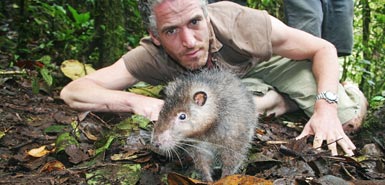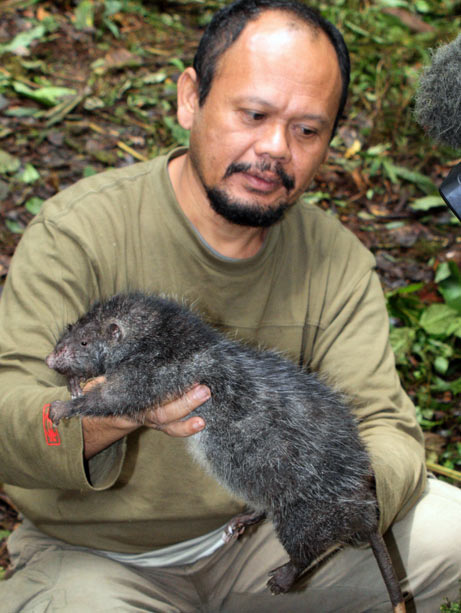
The Bosavi woolly rat (Mallomys sp.?). Photo courtesy of BBC.
September 7, 2009

The Bosavi woolly rat (Mallomys sp.?). Photo courtesy of BBC.
In a news release promoting a new series on the BBC, information has been announced on September 7, 2009, of the finds of new species, including a giant, woolly rat. (The story has been widely disseminated; see this CNN version, as well.)
A BBC film crew recording a programme in an extinct volcano in Papua New Guinea has discovered a new species of giant woolly rat, a frog with fangs, and around 40 other exotic creatures unknown to science.
Dr George McGavin and his team of biologists were stunned to spot a new species of frog within a minute of setting foot from their helicopter on the rim of the crater of Mount Bosavi.
“It was mind-blowing,” said Dr McGavin, the head scientist of the BBC Natural History unit. “Allen Allison, a specialist in amphibians, said, ‘I think that’s one there over by your foot’. I nearly trod on it.”
The woolly rat, which measures nearly 3ft (82cm) in length and weighs more than 3lb (1.5kg), was captured on film in an infrared camera trap set up on the densely wooded slopes.
Provisionally named the Bosavi woolly rat, it is thought to live only in the crater and nowhere else in the world. It has no fear of humans.
“I had a cat and it was about the same size as this rat,” said Gordon Buchanan, the cameraman who first observed the creature.
Dr McGavin said the vegetarian rat was incredibly tame: “It just sat next to me nibbling on a piece of leaf. It won’t have seen a human before. The crater of Bosavi really is the lost world.”
The animal has a silver-brown coat of long, thick fur that probably helps it to survive the wet, cold winters inside the 1,000m high crater walls.
It is thought to belong to the rodent genus Mallomys, which contains other out-sized rat species including another giant woolly rat found in the Foja Mountains of Papua New Guinea by an expedition led by Conservation International in 2007.

The similar giant rat discovered in 2007 is pictured above.
Although the Bosavi rat is about five times the size of a brown rat of the genus Rattus that is familiar in Britain, it is dwarfed by other giant rodents elsewhere in the world, such as the South American capybara, which can reach 65kg.
Steve Greenwood, series producer for Lost Land of the Volcano, said that the team clambered down into the crater from the volcano’s 2,800m summit in January with the help of local trackers, and spent two weeks filming.
They suspect that they may have catalogued for the first time up to 40 new species, including 16 species of frog, at least three new species of fish, 20 species of insect and spider and one new species of bat.
They saw stick insects the length of a man’s forearm, an extremely hairy caterpillar that Dr McGavin hopes to name after Dennis Healey’s eyebrows, and butterfies the size of a paperback book.
“Highlights include a camouflaged gecko, a fanged frog and a fish called the Henamo Grunter, so named because it makes grunting noises from its swim bladder,” Mr Greenwood said.
Steve Backshall, a climber and naturalist, described how a Bosavi silky cuscus, a fruit-eating marsupial, climbed onto his shoulder.
“I can’t begin to describe how it feels to have an animal in my hands that in all probability has never before been seen by science,” he said.
“Most biologists would consider it a great achievement to name one new species but at some points on this trip it seemed like everything we were looking at was new. The end of every day was like a massive party. It was very special.”
Lost Land of the Volcano goes out on BBC One starting tomorrow night at 9pm. The episode featuring the giant rat will be screened in two weeks’ time.
Next March 2010, the team is traveling to Bhutan in search of more new species.
++++++++++++++
Coming soon: A major announcement about the International Cryptozoology Museum. Your donations are needed urgently. Please, today, donate:
About Loren Coleman
Loren Coleman is one of the world’s leading cryptozoologists, some say “the” leading living cryptozoologist. Certainly, he is acknowledged as the current living American researcher and writer who has most popularized cryptozoology in the late 20th and early 21st centuries.
Starting his fieldwork and investigations in 1960, after traveling and trekking extensively in pursuit of cryptozoological mysteries, Coleman began writing to share his experiences in 1969. An honorary member of Ivan T. Sanderson’s Society for the Investigation of the Unexplained in the 1970s, Coleman has been bestowed with similar honorary memberships of the North Idaho College Cryptozoology Club in 1983, and in subsequent years, that of the British Columbia Scientific Cryptozoology Club, CryptoSafari International, and other international organizations. He was also a Life Member and Benefactor of the International Society of Cryptozoology (now-defunct).
Loren Coleman’s daily blog, as a member of the Cryptomundo Team, served as an ongoing avenue of communication for the ever-growing body of cryptozoo news from 2005 through 2013. He returned as an infrequent contributor beginning Halloween week of 2015.
Coleman is the founder in 2003, and current director of the International Cryptozoology Museum in Portland, Maine.
Filed under Breaking News, CryptoZoo News, New Species